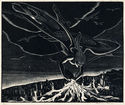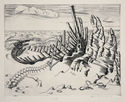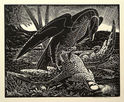
19th, 20th & 21st Century Fine Prints
707-546-7352 · fax 707-546-7924 · web: www.annexgalleries.com · email: artannex@aol.com
Roderick Mead Biography
Roderick Mead
American
1900–1971
Biography
Roderick Fletcher Mead was born 25 June 1900 in South Orange, New Jersey. He attended the Newark Academy where he received art lessons along with other academic subjects. His formal training began at Yale University, where he received his degree in fine arts in 1925. Mead then moved to New York to study at the Art Students' League. His principal teacher was the noted painter George Luks, with whom he later studied privately. Between the years 1927 and 1929, he attended the Grand Central School of Art, where he studied the watercolor technique from George Pearse Ennis, then considered the leading watercolor teacher in New York.
In 1931, Mead moved to the Spanish island of Majorca. Three years later he moved his studio to Paris, where he married Jarvis Kerr (of Paris and New York) whom he had met on Majorca. Mead soon began studying printmaking under the tutelage of Stanley William Hayter at the experimental Atelier 17. The influence of Hayter and the other artists who worked at Atelier 17 on Mead and his style cannot be underestimated. Other artists working at the Atelier during that period included Joan Miró, Pablo Picasso, Alberto Giacometti, Max Ernst, Yves Tanguy, Jean Hélion, and Wassily Kandisky. He began to experiment with abstraction and surrealism at this time. To benefit victims of the Spanish Civil War, Hayter asked Mead, Miró, Kandinsky and others to contribute a print to a portfolio illustrating the poem Fraternité by Stephen Spender (March 1939).
The Meads returned to the United States in advance of World War II, living first on Long Island, New York, Maine, and later in Sarasota, Florida. By 1941, the family was settled in Carlsbad, New Mexico which was the home of Jarvis’ father. During the war and as part of the war effort, Mead was employed in the drafting office of the Potash Company of America (1942-1944). He created the company emblem and designed machines for ore refining. Mead set up a studio in Carlsbad where he also taught classes in painting. After the war, Mead was able to devote himself to the creation of art full time. He exhibited regularly in the Southwest, New York, and in California. Following the sudden death of his son in 1951, Mead became despondent and worked very little. By 1953 he resumed painting and printmaking but rarely exhibited his work outside on New Mexico.
The Meads resumed their travels and spent the summers in Europe, returning to Carlsbad for the beginning of the school year. In the late 1950s, Mead began his best known print series, The Zodiac. The prints in this series fused science and myth, Surrealism and nature. The constellations are shown on the picture plane with the symbols they represent depicted in either biomorphically abstracted forms or with scientific precision. The period from the mid 1950s into the late 1960s was one of great activity as Mead created a large number of prints and large scale canvases. In 1968 Mead created nine wood engravings to illustrate Brandings, a collection of poems by Katherine Arnstein Heinemann (Cummington Press).
Roderick Mead survived a bout with cancer in the late 1960s and returned to work, maintaining a regular working schedule. A second cancer diagnosis in 1970 proved to be more serious, although Mead continued to create art until days before his death on May 5, 1971 in Carlsbad, New Mexico.
Submitted March 2006 by Gregory P. J. Most, Chief, Library Image Collections, National Gallery of Art, Washington, DC





